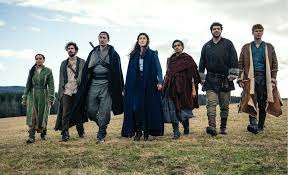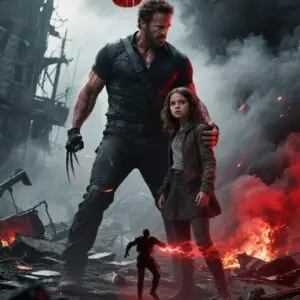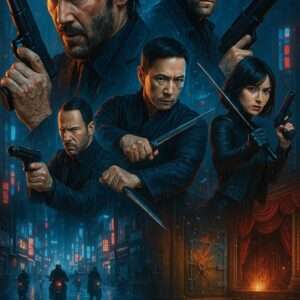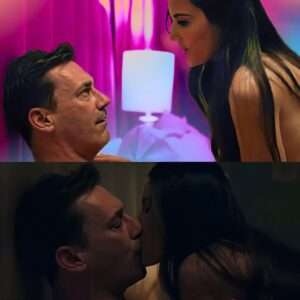Amazon Prime’s The Wheel of Time (2021) is one of the most ambitious—and controversial—fantasy adaptations in recent memory. Based on Robert Jordan’s sprawling 14-book epic, the series had enormous shoes to fill, with a fanbase as passionate as Lord of the Rings or Game of Thrones. But does it succeed as both an adaptation and a standalone fantasy series? The answer, much like the Wheel itself, is cyclical: there are moments of brilliance, frustrating missteps, and enough potential to keep viewers cautiously optimistic for the future.
Premise and Setting: A World Both Familiar and New
For the uninitiated, The Wheel of Time is set in a high-fantasy world where history repeats itself in an endless cycle. Magic exists in the form of the One Power, wielded by women called Aes Sedai, while men who channel it go mad due to a centuries-old corruption. The story follows Moiraine Damodred (Rosamund Pike), an Aes Sedai who believes one of five young villagers—Rand al’Thor (Josha Stradowski), Egwene al’Vere (Madeleine Madden), Perrin Aybara (Marcus Rutherford), Mat Cauthon (Barney Harris, later replaced by Dónal Finn), and Nynaeve al’Meara (Zoë Robins)—could be the reincarnation of the Dragon, a prophesied figure destined to either save or destroy the world.

The show’s greatest strength is its worldbuilding. Jordan’s books are dense with lore, cultures, and political intrigue, and the series does an admirable job of condensing this into digestible television. The Aes Sedai’s White Tower, the monstrous Trollocs, and the ominous figure of the Dark One are all introduced effectively. However, some fans argue that the adaptation sacrifices depth for pacing, particularly in character development.
Strengths: What Works
1. Rosamund Pike as Moiraine – A Perfect Casting Choice
Pike is the show’s anchor, bringing gravitas, mystery, and emotional depth to Moiraine. Her performance elevates every scene she’s in, making her the most compelling character by far. The decision to center the first season more on her perspective (rather than Rand’s, as in the books) is controversial but pays off in making the story more accessible to newcomers.

2. Stunning Visuals and Production Design
Amazon spared no expense, and it shows. The landscapes (filmed in the Czech Republic, Slovenia, and Croatia) are breathtaking, and the costumes—particularly the Aes Sedai’s color-coded Ajah robes—are meticulously crafted. The magic system, visualized as weaves of light, is one of the best depictions of spellcasting in fantasy TV.
3. Strong Female Characters
One of Jordan’s defining traits was his focus on powerful women, and the show amplifies this. Nynaeve and Egwene’s arcs are given more immediate weight, and their struggles feel visceral. Zoë Robins’ portrayal of Nynaeve, in particular, stands out—her raw intensity in moments like her emotional outburst of channeling is a highlight.
4. Pacing and Accessibility
Condensing The Eye of the World (a 700+ page novel) into eight episodes was always going to be a challenge. While some fans lament missing book moments, the streamlined approach makes the story more digestible for general audiences. The season’s climax, though divisive, is undeniably bold.
Weaknesses: What Doesn’t Work
1. Uneven Character Development
Rand, the book’s primary protagonist, feels sidelined for much of the season. His big reveal in the finale lacks the emotional punch it should have because his arc wasn’t given enough buildup. Similarly, Perrin’s internal struggle (a major theme in the books) is reduced to a few brooding stares and one traumatic incident.
2. Changes from the Source Material

Some alterations work (Moiraine’s expanded role), but others feel unnecessary. Mat’s darker, more troubled portrayal early on was controversial, especially since Barney Harris’ departure left the character in limbo. The decision to make the Dragon’s identity a mystery (when it’s clear early in the books) also led to mixed reactions.
3. Inconsistent CGI and Action Sequences
While the magic effects are gorgeous, some battle scenes (particularly the Trolloc attacks) suffer from shaky CGI. The finale’s large-scale battle feels rushed and underwhelming compared to the book’s version.
4. Pacing Issues in the Back Half
The first few episodes establish the world well, but the middle sags under exposition. Then, the finale speeds through major events, leaving some viewers confused.
Season 1 Verdict: A Flawed but Promising Start
The Wheel of Time is not a perfect adaptation, nor is it a flawless fantasy series. However, it’s a solid foundation for what could become something great. The casting is mostly excellent, the world feels alive, and the changes—while sometimes frustrating—suggest a willingness to take risks rather than slavishly follow the books.
Rating: 7.5/10
“A visually stunning, uneven, but ultimately engaging fantasy series that improves upon rewatch. If future seasons deepen character arcs and tighten pacing, it could become a genre classic.”
Looking Ahead: What Needs to Improve in Season 2
- Focus on Rand’s Journey – Now that his identity is revealed, he needs more depth.
- Better Villain Presence – The Dark One and Forsaken should feel like real threats.
- More Political Intrigue – The Aes Sedai’s scheming should play a bigger role.
- Improved Action Choreography – The fights need to match the magic’s visual splendor.
Final Thoughts: Should You Watch It?
- For Book Fans: You’ll either appreciate the fresh take or resent the changes. Give it a chance with an open mind.
- For Newcomers: If you love fantasy, this is worth your time—just don’t expect Game of Thrones levels of complexity yet.
- For Casual Viewers: The strong visuals and Rosamund Pike’s performance make it enjoyable, even if the story occasionally stumbles.
The Wheel of Time turns, and hopefully, the next season will be an improvement. As of now? It’s a flawed but fascinating start to a saga that could still become legendary.





